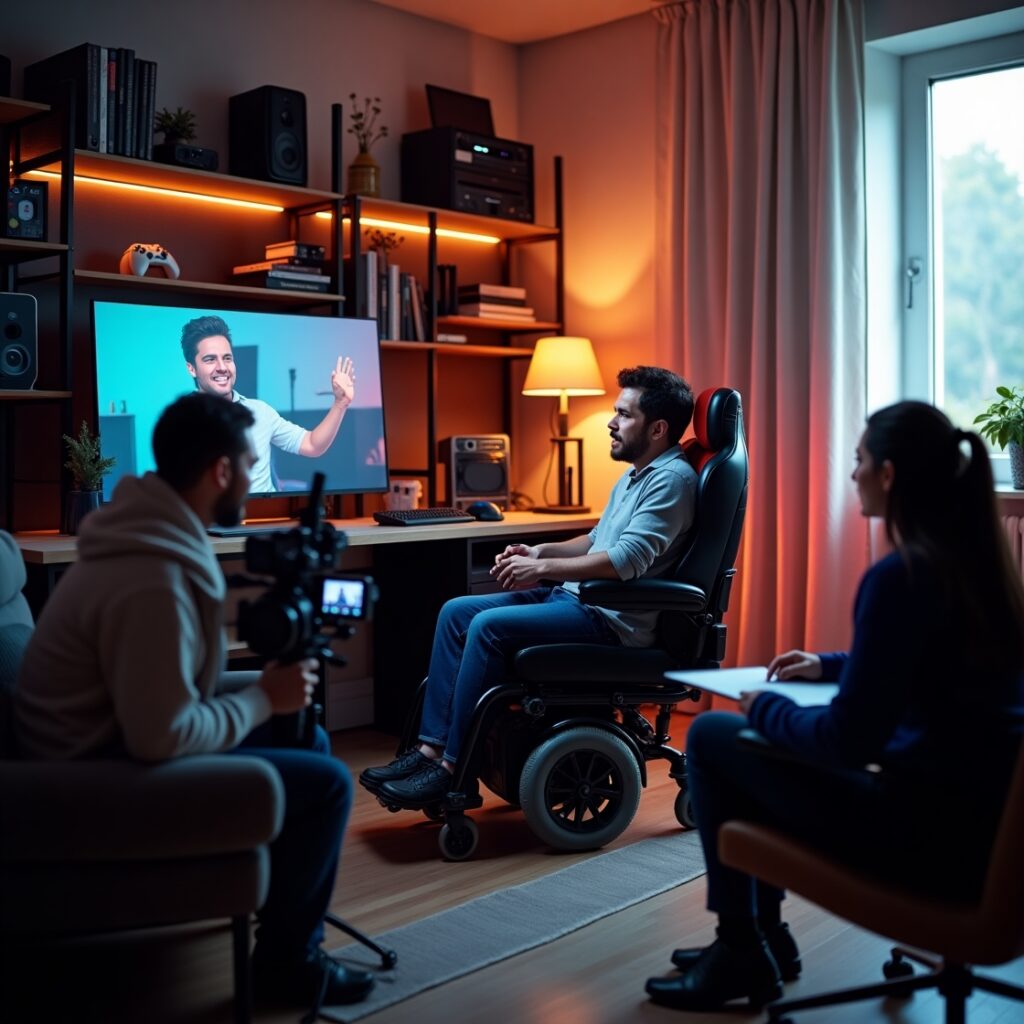Interviews & Spotlights: Streamers Who Champion Accessibility shine a light on creators who are making the streaming world more inclusive. These inspiring voices show how accessibility isn’t just about tools—it’s about leadership, creativity, and connection.
Introduction
Interviews & Spotlights: Streamers Who Champion Accessibility celebrate those in the streaming world who are breaking down barriers and building up inclusive communities. From visually impaired creators to streamers with mobility challenges, these stories prove that accessibility isn’t a limitation—it’s a strength. In this post, we highlight key interviews, real success stories, and the favorite tools of disabled streamers.
Interviews with Streamers Who Champion Accessibility
Hearing directly from streamers who prioritize accessibility gives valuable insight into their journey, challenges, and tips for creating inclusive content.
🎤 What They Share:
- Their personal streaming setup and accessibility modifications
- How they communicate with their audience about inclusion
- What tools or platforms work best for them
- Advice for new streamers who want to be more inclusive
These streamers often advocate for better features on platforms like Twitch, YouTube, and Kick—and their feedback helps shape the future of streaming.
How This Visually Impaired Streamer Built an Inclusive Channel
🌟 Example: Ross Minor – Blind Streamer & Accessibility Advocate
Ross Minor is a legally blind content creator, streamer, and former Paralympic swimmer who has built a deeply educational and inclusive online community.
- Platform & Content: Ross shares how he plays video games (like Mortal Kombat X) using accessibility techniques, reviews tech with accessibility in mind, and educates viewers about living and streaming as a blind person
- Setup Highlights:
- Uses screen readers and audio cues to navigate both games and streaming software.
- Describes gameplay and interface logs out loud to ensure all viewers can follow along.
- Reviews accessible gear and advocates for more inclusive gaming practices.
- Impact:
- Educates both disabled and non-disabled audiences on accessible tech.
- Works with big developers like EA to improve game accessibility.
- Regularly demonstrates technology in action—showing blind viewers how to live fully and stream confidently
🎥 Ross Minor on YouTube
📌 Channel: RossMinor
You can visit it directly 👉 https://www.youtube.com/c/rossminor
Ross isn’t just streaming games—he’s building awareness, showcasing inclusive design in action, and opening doors for all streamers to think inclusively.
Tools Recommended by Disabled Streamers
Many disabled creators rely on specific tools to make streaming easier and more accessible—for themselves and their audience.
🔧 Top Recommended Tools:
| Tool | What It Does | Who It Helps |
|---|---|---|
| OBS Studio + Accessibility Plugins | Scene control with larger text/UI | Vision impairments |
| Xbox Adaptive Controller | Fully customizable game controller | Limited mobility |
| VoiceAttack | Set voice commands for streaming tasks | Mobility or fatigue issues |
| Tobii Eye Tracker | Control games or mouse with eye movement | Paralysis or limited hand use |
| Stream Captioners | Auto-captions for live streams | Deaf/hard of hearing audiences |
| Stream Deck | One-touch control for scenes, sounds, commands | All creators for easier management |
These tools aren’t just useful—they’re empowering. They allow streamers to show up fully, focus on content, and connect with their communities.
Free and Paid Captioning Services for Streamers
Captions are essential for making streams accessible to deaf or hard-of-hearing viewers—and even helpful for viewers who watch on mute. Whether you’re just getting started or looking for pro-level tools, there are free and paid options to suit every type of streamer.
💸 Free Captioning Tools:
- OBS Studio + OBS Captions Plugin: Add live speech-to-text captions directly into your stream using Google’s Speech Recognition API.
- Web Captioner: A browser-based tool that converts spoken words into captions in real-time. Easy to use and free with no software required.
- Twitch’s Native Captions (beta): Twitch offers basic captions for streamers using compatible software like OBS or Streamlabs.
💰 Paid Captioning Services:
- 1CapApp: Real-time human captioning with professional transcribers. Great for high-profile or sponsored events.
- Rev Live Captions: Integrates with Zoom, OBS, and other tools. Offers professional captions with high accuracy.
- StreamText: Used by CART professionals to stream real-time text to your video.
⚖️ Choosing the Right Option:
- For casual or part-time streamers: Free tools like Web Captioner or OBS plugins work great.
- For professionals or accessibility advocates: Paid services offer higher accuracy and reliability—ideal for larger audiences or monetized streams.
🎯 Pro Tip: No matter which tool you use, always let your viewers know in chat or in a stream overlay that captions are available!
Final Thoughts
Interviews & Spotlights: Streamers Who Champion Accessibility remind us that accessibility is human. Behind every tool is a person who needed it—and behind every adjustment is a story of creativity, resilience, and connection. Featuring and learning from disabled streamers is one of the best ways to build better, more inclusive spaces online.
If you’re a streamer or viewer passionate about accessibility, share your story—you never know who it might inspire.
